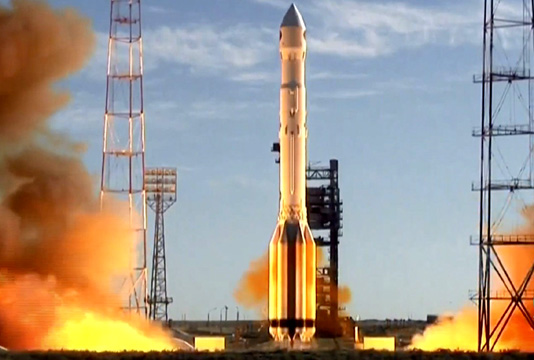MOSCOW, July 14, 2019 (BSS/AFP) – Russia launched a space telescope
Saturday from the cosmodrome in Baikonur, Kazakhstan, in a joint mission with
Germany intended to map X-rays across the sky and replace a project lost in
January.
Video posted on the website of the Roskosmos, the Russian space agency,
showed a Proton-M rocket carrying the Spektr-RG taking off from the launch
pad at Baikonur at 1230 GMT.
The launch of the scope, weighing more than 2.7 tonnes, was originally
scheduled for June 21 but was postponed twice because of a battery problem.
The Spektr-RG, developed with Germany, is a space observatory intended to
replace the Spektr-R, known as the “Russian Hubble”, which Roskosmos said it
lost control of in January.
Spektr-R was launched in 2011 to observe black holes, neutron stars and
magnetic fields, aiding understanding of cosmic expansion. Its successor will
take up similar duties but will also work on completing a high-resolution
all-sky map, said Roskosmos.
– Russia facing competition for ISS links –
Russia’s space programme, long a source of great pride to the nation, has
suffered a series of humiliating setbacks in recent years, although the
country remains committed to ambitious projects
“The observation of space by Spektr-RG will mark a new stage in X-ray
astronomy, whose history goes back more than 55 years,” said the Russian
space agency, adding the project would permit “the year-round observation of
practically the whole celestial sphere,” the imaginary sphere formed by our
universe.
Since 2011, Russia has been the only country capable of sending teams to
the International Space Station (ISS).
But a series of recent setbacks together with corruption scandals within
Roskosmos and the competition from Elon Musk’s SpaceX have threatened its
monopoly.
The next launch to the ISS is scheduled for July 20 . It will carry an
Italian and a US astronaut together with a Russian cosmonaut.
The telescope’s research mission is set to last for six-and-a-half years
including a four-year scan of the heavens and the remainder spent observing
objects in space “at the behest of the international scientific community,”
the agency statement said.
It will take some three months to reach its destination, an observing
position some 1.5 million kilometres (900,000 miles) above Earth.
It is expected the telescope will uncover around three million super-
massive black holes during its lifetime as well as some 100,000 massive
galaxy clusters strung out across the known universe, the agency added.



